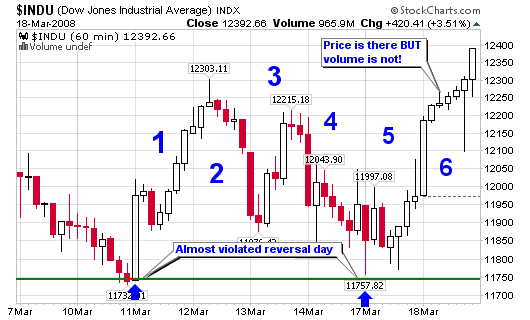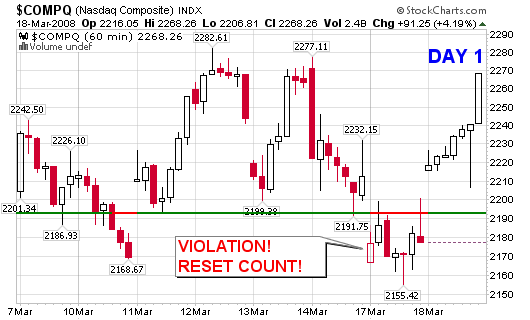I was inspired to write this educational piece after listening to the audio interview between Tim Bourquin of Trader Interviews and Brian Shannon of Alphatrends.net, also the author of Technical Analysis Using Multiple Timeframes. Brian’s book starts shipping on June 7, 2008, a book I had the pleasure to read as an advance copy; I definitely recommend his work. I will be posting a complete review of the book within the next week.
- Which stock would you buy below based on the nameless & dateless charts? (listed 1,2,3,4)
- How would you rank them in order of technical characteristics?
- Would you avoid buying of any of the stocks below based on price and volume?
- Would you short any of the stocks below?

Tim mentioned that a couple traders he recently spoke with have written code within their charting software that allows them to strip the company name and ticker symbol off of the charts. I find this absolutely amazing – a tool I would pay for in a heart beat.
These traders do this to avoid the human biases of the companies they are trading. Humans tend to rationalize their thoughts and decisions based on what has happened, what is currently happening and what they think will happen.
For example (one provided in the interview that I agree with): Many traders are starting to talk about a bubble or possible top in oil. Now, I don’t know if oil is topping but I have been avoiding some oil and energy stocks in my own research based on the indicators of my screens. I truly can’t tell you if this is based on the biases of what I have been reading and hearing or the based on my screens dropping clues.
I typically avoid old time blue chip stocks such as GM, IBM and MSFT but maybe I wouldn’t do this if they were making a move and I didn’t know what company I was trading because the ticker symbol was stripped. I did analyze IBM earlier this year but I avoided the write-up for as long as possible because it has underperformed for much of my adult life.
Anyway, take a look at the stock charts below and let us all know (in the comments) which ones you would buy, sell or do nothing. I will post up the full charts with ticker symbols and dates in a couple of days. Some of you may be very surprised to see what stocks they really are and may question your own conclusions once the company names are revealed.
Good luck – let’s see what everyone comes up with (leave them in the comments section). Click through to see charts 2 through 4.





Connect with Me